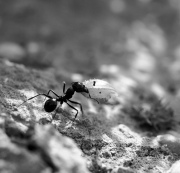I mentioned a while ago that I’d been invited to write about evolution for Nature’s Scitable blog network. The network finally relaunched this week and my new group blog, Accumulating Glitches, went live earlier today! Together with Sarah Jane Alger, I’ll be writing about how evolution works and the amazing world it has created — “exploring the grandeur of evolution”. We’re planning to post every Monday and I hope you’ll join us there — we’ve got lots of exciting stories to share! For now, here’s a taste of the inaugural post:
Faced with the rich diversity of living beings around us, humans have proven unable to resist the temptation to try to organize and categorize them. We have a natural tendency to classify things, a habit that’s deeply rooted in our cognition and use of language. Our brain excels at recognizing patterns (and thus finding meaning where it doesn’t exist), an ability that allows us to interact with the world using names — like “chair” — that we might be hard-pressed to properly explain. In fact, it’s surprisingly difficult to define even a seemingly straightforward word like “chair” in a way that would let us recognize everything that should be included (from office chairs and recliners to stools and wheelchairs) but nothing that shouldn’t (like tables, tree stumps, or other things we might decide to sit on).
Despite these difficulties, we’ve been classifying organisms throughout the history of human thought, from Aristotle’s division between plants and animals to modern scientific nomenclature. The modern classification system is based on grouping organisms into units called ‘species’; species, in turn, group together into a larger units called genus, family, order, and so on through the nested hierarchy of life. What make a species, though? Why should a particular group of organisms be thought of as a unit and given a distinct name? How do we decide which organisms make up a species?
Read the rest over at Accumulating Glitches…
 It’s November! That’s not usually an exciting time for me (Helsinki is cold, dark, and wet in November), but this year is an exception. In just under three weeks, I’ll be moving to another continent and starting to write full time! I’m really excited about the change and eager to get started with the next phase of my life…and I’m also very busy with the process of getting there, so Inspiring Science will be more quiet than usual over the next few weeks. Hopefully I’ll manage to find the time to post something, but in the meantime here are some tidbits to tide you over. (If that’s not enough for you, have a gander through some of the old posts or previous linkfests.) As always, feel free to add more links in the comments!
It’s November! That’s not usually an exciting time for me (Helsinki is cold, dark, and wet in November), but this year is an exception. In just under three weeks, I’ll be moving to another continent and starting to write full time! I’m really excited about the change and eager to get started with the next phase of my life…and I’m also very busy with the process of getting there, so Inspiring Science will be more quiet than usual over the next few weeks. Hopefully I’ll manage to find the time to post something, but in the meantime here are some tidbits to tide you over. (If that’s not enough for you, have a gander through some of the old posts or previous linkfests.) As always, feel free to add more links in the comments!


You must be logged in to post a comment.